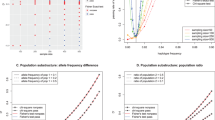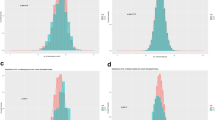Abstract
In case–control association studies, it is typical to observe several associated polymorphisms in a gene region. Often the most significantly associated polymorphism is considered to be the disease polymorphism; however, it is not clear whether it is the disease polymorphism or there is more than one disease polymorphism in the gene region. Currently, there is no method that can handle these problems based on the linkage disequilibrium (LD) relationship between polymorphisms. To distinguish real disease polymorphisms from markers in LD, a method that can detect disease polymorphisms in a gene region has been developed. Relying on the LD between polymorphisms in controls, the proposed method utilizes model-based likelihood ratio tests to find disease polymorphisms. This method shows reliable Type I and Type II error rates when sample sizes are large enough, and works better with re-sequenced data. Applying this method to fine mapping using re-sequencing or dense genotyping data would provide important information regarding the genetic architecture of complex traits.

Similar content being viewed by others
References
Altshuler D, Brooks LD, Chakravarti A, Collins FS, Daly MJ, Donnelly P (2005) A haplotype map of the human genome. Nature 437(7063):1299–1320
Altshuler D, Daly MJ, Lander ES (2008) Genetic mapping in human disease. Science 322(5903):881–888. doi:322/5903/881[pii]10.1126/science.1156409
Barrett JC, Fry B, Maller J, Daly MJ (2005) Haploview: analysis and visualization of ld and haplotype maps. Bioinformatics 21(2):263–265
Barrett JC, Clayton DG, Concannon P, Akolkar B, Cooper JD, Erlich HA, Julier C, Morahan G, Nerup J, Nierras C et al (2009) Genome-wide association study and meta-analysis find that over 40 loci affect risk of type 1 diabetes. Nat Genet. doi:ng.381[pii]10.1038/ng.381
Biernacka JM, Cordell HJ (2009) A composite-likelihood approach for identifying polymorphisms that are potentially directly associated with disease. Eur J Hum Genet 17(5):644–650. doi:ejhg2008242[pii]10.1038/ejhg.2008.242
Biernacka JM, Charoen P, Cordell HJ (2007) Joint linkage and association analysis for identification of potentially causal polymorphisms in gaw15 data. BMC Proc 1(Suppl 1):S36
Charoen P, Biernacka JM, Cordell HJ (2007) Linkage and association analysis of gaw15 simulated data: fine-mapping of chromosome 6 region. BMC Proc 1(Suppl 1):S23
Cho YS, Go MJ, Kim YJ, Heo JY, Oh JH, Ban HJ, Yoon D, Lee MH, Kim DJ, Park M et al (2009) A large-scale genome-wide association study of Asian populations uncovers genetic factors influencing eight quantitative traits. Nat Genet 41(5):527–534. doi:ng.357[pii]10.1038/ng.357
Cordell HJ, Clayton DG (2002) A unified stepwise regression procedure for evaluating the relative effects of polymorphisms within a gene using case/control or family data: application to hla in type 1 diabetes. Am J Hum Genet 70(1):124–141. doi:S0002-9297(07)61288-9[pii]10.1086/338007
Dickson SP, Wang K, Krantz I, Hakonarson H, Goldstein DB (2010) Rare variants create synthetic genome-wide associations. PLoS Biol 8(1):e1000294. doi:10.1371/journal.pbio.1000294
Easton DF, Pooley KA, Dunning AM, Pharoah PD, Thompson D, Ballinger DG, Struewing JP, Morrison J, Field H, Luben R et al (2007) Genome-wide association study identifies novel breast cancer susceptibility loci. Nature 447(7148):1087–1093. doi:nature05887[pii]10.1038/nature05887
Erdmann J, Grosshennig A, Braund PS, Konig IR, Hengstenberg C, Hall AS, Linsel-Nitschke P, Kathiresan S, Wright B, Tregouet DA et al (2009) New susceptibility locus for coronary artery disease on chromosome 3q22.3. Nat Genet 41(3):280–282. doi:ng.307[pii]10.1038/ng.307
Frazer KA, Ballinger DG, Cox DR, Hinds DA, Stuve LL, Gibbs RA, Belmont JW, Boudreau A, Hardenbol P, Leal SM et al (2007) A second generation human haplotype map of over 3.1 million snps. Nature 449(7164):851–861. doi:nature06258[pii]10.1038/nature06258
Hardy J, Singleton A (2009) Genomewide association studies and human disease. N Engl J Med 360(17):1759–1768. doi:NEJMra0808700[pii]10.1056/NEJMra0808700
Manolio TA, Collins FS, Cox NJ, Goldstein DB, Hindorff LA, Hunter DJ, McCarthy MI, Ramos EM, Cardon LR, Chakravarti A et al (2009) Finding the missing heritability of complex diseases. Nature 461(7265):747–753. doi:nature08494[pii]10.1038/nature08494
Maris JM, Mosse YP, Bradfield JP, Hou C, Monni S, Scott RH, Asgharzadeh S, Attiyeh EF, Diskin SJ, Laudenslager M et al (2008) Chromosome 6p22 locus associated with clinically aggressive neuroblastoma. N Engl J Med 358(24):2585–2593. doi:NEJMoa0708698[pii]10.1056/NEJMoa0708698
Nickerson DA, Taylor SL, Fullerton SM, Weiss KM, Clark AG, Stengard JH, Salomaa V, Boerwinkle E, Sing CF (2000) Sequence diversity and large-scale typing of snps in the human apolipoprotein e gene. Genome Res 10(10):1532–1545
Nicodemus KK, Stenger JE, Schmechel DE, Welsh-Bohmer KA, Saunders AM, Roses AD, Gilbert JR, Vance JM, Haines JL, Pericak-Vance MA et al (2004) Comprehensive association analysis of apoe regulatory region polymorphisms in alzheimer disease. Neurogenetics 5(4):201–208
Park L (2007) Controlling linkage disequilibrium in association tests: revisiting apoe association in Alzheimer’s disease. Genomics Inform 5(2):61–67
Qin ZS, Niu T, Liu JS (2002) Partition-ligation-expectation-maximization algorithm for haplotype inference with single-nucleotide polymorphisms. Am J Hum Genet 71(5):1242–1247
Schaid DJ, Rowland CM, Tines DE, Jacobson RM, Poland GA (2002) Score tests for association between traits and haplotypes when linkage phase is ambiguous. Am J Hum Genet 70(2):425–434. doi:S0002-9297(07)63956-1[pii]10.1086/338688
Scott LJ, Muglia P, Kong XQ, Guan W, Flickinger M, Upmanyu R, Tozzi F, Li JZ, Burmeister M, Absher D et al (2009) Genome-wide association and meta-analysis of bipolar disorder in individuals of European ancestry. Proc Natl Acad Sci USA 106(18):7501–7506. doi:0813386106[pii]10.1073/pnas.0813386106
Shete S, Hosking FJ, Robertson LB, Dobbins SE, Sanson M, Malmer B, Simon M, Marie Y, Boisselier B, Delattre JY et al (2009) Genome-wide association study identifies five susceptibility loci for glioma. Nat Genet 41(8):899–904. doi:ng.407[pii]10.1038/ng.407
Song H, Ramus SJ, Tyrer J, Bolton KL, Gentry-Maharaj A, Wozniak E, Anton-Culver H, Chang-Claude J, Cramer DW, DiCioccio R et al (2009) A genome-wide association study identifies a new ovarian cancer susceptibility locus on 9p22.2. Nat Genet 41(9):996–1000. doi:ng.424[pii]10.1038/ng.424
Szymczak S, Biernacka JM, Cordell HJ, Gonzalez-Recio O, Konig IR, Zhang H, Sun YV (2009) Machine learning in genome-wide association studies. Genet Epidemiol 33(Suppl 1):S51–S57. doi:10.1002/gepi.20473
Unoki H, Takahashi A, Kawaguchi T, Hara K, Horikoshi M, Andersen G, Ng DP, Holmkvist J, Borch-Johnsen K, Jorgensen T et al (2008) Snps in kcnq1 are associated with susceptibility to type 2 diabetes in East Asian and European populations. Nat Genet 40(9):1098–1102. doi:ng.208[pii]10.1038/ng.208
Wellcome Trust Case Control Consortium (2007) Genome-wide association study of 14,000 cases of seven common diseases and 3,000 shared controls. Nature 447(7145):661–678. doi:nature05911[pii]10.1038/nature05911
Wrensch M, Jenkins RB, Chang JS, Yeh RF, Xiao Y, Decker PA, Ballman KV, Berger M, Buckner JC, Chang S et al (2009) Variants in the cdkn2b and rtel1 regions are associated with high-grade glioma susceptibility. Nat Genet 41(8):905–908. doi:ng.408[pii]10.1038/ng.408
Yasuda K, Miyake K, Horikawa Y, Hara K, Osawa H, Furuta H, Hirota Y, Mori H, Jonsson A, Sato Y et al (2008) Variants in kcnq1 are associated with susceptibility to type 2 diabetes mellitus. Nat Genet 40(9):1092–1097. doi:ng.207[pii]10.1038/ng.207
Yu Z, Schaid DJ (2007) Sequential haplotype scan methods for association analysis. Genet Epidemiol 31(6):553–564. doi:10.1002/gepi.20228
Yu CE, Seltman H, Peskind ER, Galloway N, Zhou PX, Rosenthal E, Wijsman EM, Tsuang DW, Devlin B, Schellenberg GD (2007) Comprehensive analysis of apoe and selected proximate markers for late-onset Alzheimer’s disease: patterns of linkage disequilibrium and disease/marker association. Genomics 89(6):655–665. doi:S0888-7543(07)00050-X[pii]10.1016/j.ygeno.2007.02.002
Acknowledgments
This work was supported by the Korea Research Foundation Grant funded by the Korean Government (MOEHRD) (KRF-2007-532-C00017) and by the National Research Foundation of Korea Grant funded by the Korean Government (NRF-2009-353-C00061). The key calculations were performed using the supercomputing resource at the Korea Institute of Science and Technology Information (KISTI), supported by grant No. KSC-2009-S01-0003 from KISTI.
Author information
Authors and Affiliations
Corresponding author
Rights and permissions
About this article
Cite this article
Park, L. Identifying disease polymorphisms from case–control genetic association data. Genetica 138, 1147–1159 (2010). https://doi.org/10.1007/s10709-010-9505-5
Received:
Accepted:
Published:
Issue Date:
DOI: https://doi.org/10.1007/s10709-010-9505-5




